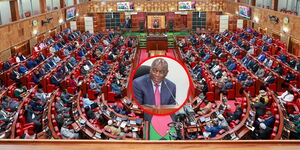Following the submission of the proposed Fourth Basis for Sharing Revenues among counties by the Commission on Revenue Allocation (CRA), a section of senators have heavily opposed it.
CRA Chairperson Mary Chebukati Wanyonyi made the presentation during the ongoing mid-term retreat for Senators in Naivasha on Thursday, February 6, 2025.
Among the top complaints the Senators raised was the introduction of a new revenue-sharing formula while the previous one had not been fully implemented and was working perfectly.
“If the machine is working, you don’t have to fix it,” Kakamega County Senator Boni Khalwale opined.
Senate Majority Leader Aaron Cheruiyot backed this assertion, urging the Senate Finance Committee to critically examine the proposal and provide accurate data to facilitate an informed decision and called for evidence-based discussions.
Nairobi's Edwin Sifuna on his side noted, "I will not appreciate any formula that will make Nairobi or any other county lose money."
Although Counties are slated to receive Ksh417 billion for the financial year 2025/2026 in the new system, they also pointed out the clear lack of ways to mitigate the stealing and mismanagement of County funds by County officials.
A few even proposed a reduction of the allocations to such counties to enhance fiscal prudence.
However, the proposal was quickly shut down by the Senate's Deputy Speaker Kathuri Murungi who noted that the oversight role of the Senators did not include punishing county residents for the actions of their Governors.
The new formula will see counties allocated funds based on several parameters including; population, equal share, geographical size, poverty levels, and income distance.
The population will determine 42 per cent of the allocation, equal share 22 per cent, poverty levels 14 per cent, income distance 13 per cent, and finally geographical size nine per cent.
Although heavily opposed, CPA Wanyonyi, the wife of former Independent Boundaries and Elections Commission (IEBC) Chair Wafula Chebukati, outlined how CRA arrived at the new formula.
During her presentation, she justified the proposed framework, stating that it would enable county governments to effectively perform their functions while also taking into consideration their fiscal capacity, efficiency, and developmental needs.
She argued it would address economic disparities among counties while promoting affirmative action for disadvantaged areas and groups. It would also reportedly encourage counties to optimise their revenue generation capacity.
The Senators will conduct a thorough interrogation of the formula before making a resolution when they resume House sittings on Tuesday, February 11.
With the proposal now before the Senate, legislators are expected to conduct a thorough interrogation of the formula before making a resolution when the House resumes its sittings on Tuesday, February 11, 2025.
Once passed, it will serve through the 2025/2026 to 2029/2030 financial years.












